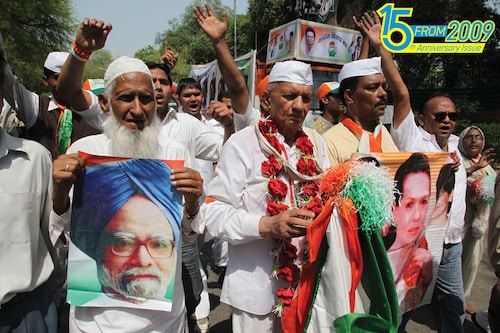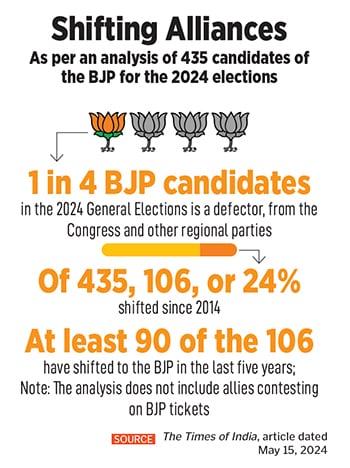Congress: Once ruling party, now a house of cards
The Congress had an impressive victory in the 2009 elections, but in the following years it unravelled and paved the way for the ascendancy of the BJP


The general election of May 2009 was momentous for the Indian National Congress (INC). In its biggest victory since 1991, it won 206 (of 543) seats in the Lok Sabha, against 116 notched up by Bharatiya Janata Party (BJP). It was also the first time in 25-odd years that the incumbent government had been re-elected after completing one full term.
Manmohan Singh, the architect of the economic reforms of 1991, would return as Prime Minister for the second time after 2004, when the Congress had formed the government with a coalition of parties called the United Progressive Alliance (UPA).
In 2009, Singh became the first PM since Jawaharlal Nehru to be reinstated after completing one full term. He would also go on to become the first PM since Indira Gandhi to complete two full terms.
The Congress had won the mandate of the people in 2009 largely on the back of the welfare-led policies they had implemented in their first term. This included the landmark Right to Information Act, and the National Rural Employment Guarantee Act. The Indo-US Civil Nuclear Deal, which solidified India’s position as a nuclear power, was also signed during this term.
Over the next five years, however, the tables turned. Alleged corruption scandals were uncovered, including the coal block allocation scam, the 2G spectrum scam, and the Commonwealth Games scam. There were demonstrations and rallies across India, which also led to the formation of the Aam Aadmi Party (AAP) under Arvind Kejriwal in 2012.
 “India, during the UPA, was steady with its Gross Domestic Product growth when the world crumbled under the weight of a global economic crisis," says journalist and political analyst Preethi Nagaraj. “But the Congress, it seemed, became too comfortable with its victories. It neither took responsibility for, nor made efforts to explain itself in the face of corruption scandals. It just let it slide."
“India, during the UPA, was steady with its Gross Domestic Product growth when the world crumbled under the weight of a global economic crisis," says journalist and political analyst Preethi Nagaraj. “But the Congress, it seemed, became too comfortable with its victories. It neither took responsibility for, nor made efforts to explain itself in the face of corruption scandals. It just let it slide."
The UPA also started becoming more factious, and there were tensions with partners, says journalist Nilanjan Mukhopadhyay, author of a biography on Prime Minister Narendra Modi.
Riding on these developments, the BJP campaign for the 2014 elections—in which it also leveraged social media—spoke of radical change. “It promised potential voters an efficient, corruption-free government that would deliver on ambitious development projects, generate employment opportunities, strengthen India’s position in the world through a more aggressive approach to national security and foreign policy, and—importantly—pave the way for India’s “true Hindu identity" to flourish," says a December 2023 article by Nicholas Haas and Rajeshwari Majumdar for the Carnegie Endowment for International Peace.
“The idea for a majoritarian, authoritarian leader had come into India at that time, and we saw the emergence of Modi. His popularity made sure leaders within the BJP and the Rashtriya Swayamsevak Sangh backed him as the prime ministerial candidate, even if they had reservations," says Mukhopadhyay. He adds that in India, elections are fought on narratives woven by leaders, and Modi was able to weave convincing narratives that led people to vote for BJP.
In the 2019 elections, while the BJP secured 303 seats, the Congress went down to 52. Over time, they have lost vital states like Rajasthan, Chhattisgarh, Maharashtra and Madhya Pradesh, and also their home turf Amethi.
“The Congress has also been top-heavy, where everybody is a leader, but nobody wants to take ownership," says Nagaraj. “It seemed like it had given up on the 2024 elections even before it took place, but then the Bharat Jodo yatra happened, where the party—led by Rahul Gandhi—did a good job of pushing for approval of the people."
 Over the last decade, the Congress has seen many members, some of whom were generational loyalists, join other parties, mostly the BJP. In the 2024 elections, for instance, one in four BJP candidates was a defector from Congress and other parties, as per The Times of India in a report dated May 15, 2024 (see box).
Over the last decade, the Congress has seen many members, some of whom were generational loyalists, join other parties, mostly the BJP. In the 2024 elections, for instance, one in four BJP candidates was a defector from Congress and other parties, as per The Times of India in a report dated May 15, 2024 (see box).
“If it appears that the Congress is not fighting back adequately, the dwindling number of its legislators is also a reason," says Nagaraj. “It needs a higher vote share to be a strong opposition on the floor of Parliament."
Mukhopadhyay adds that the BJP welcoming defectors, irrespective of ideologies or loyalty, has not gone unnoticed by their own party members, who are upset because they spent decades in the BJP aspiring to rise up the hierarchy. “It is not that these movements are not creating any problems within the BJP, but we will only know in June if, and how, that has impacted its election performance," he says.
Even if the Congress shows signs of revival in the 2024 elections, it’s likely to be some time before the turnaround is complete.
First Published: May 29, 2024, 11:57
Subscribe Now